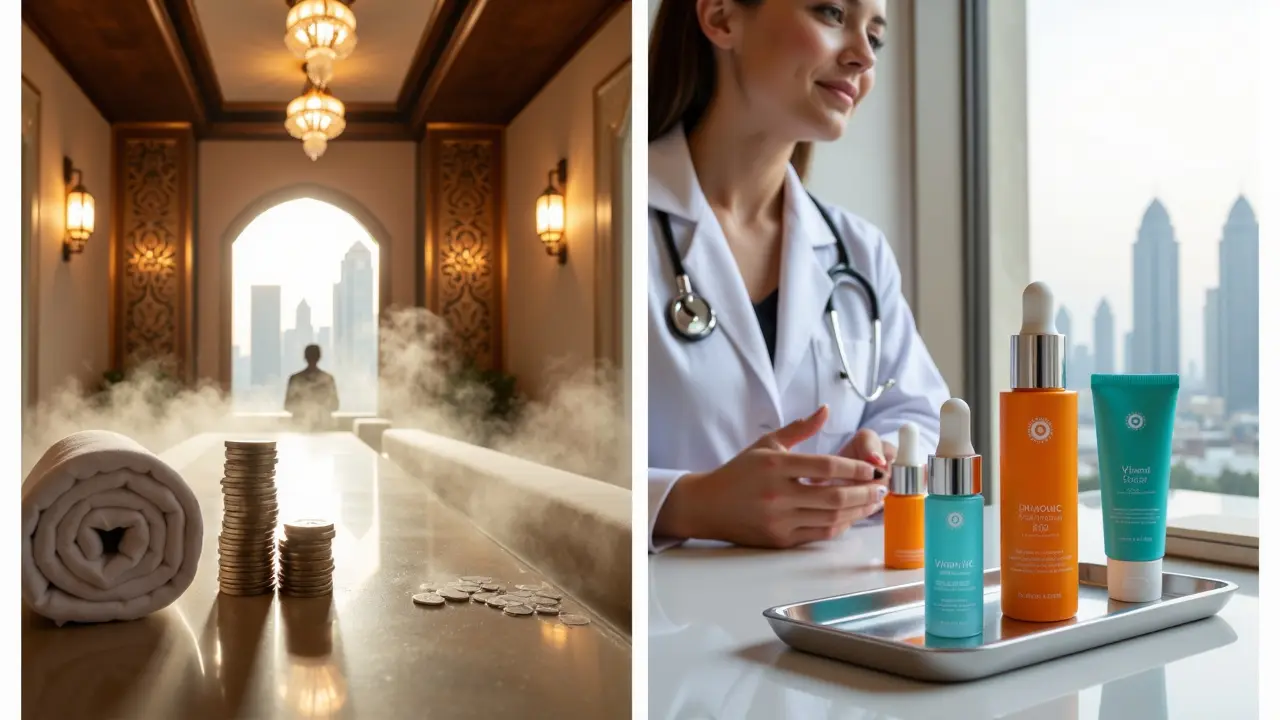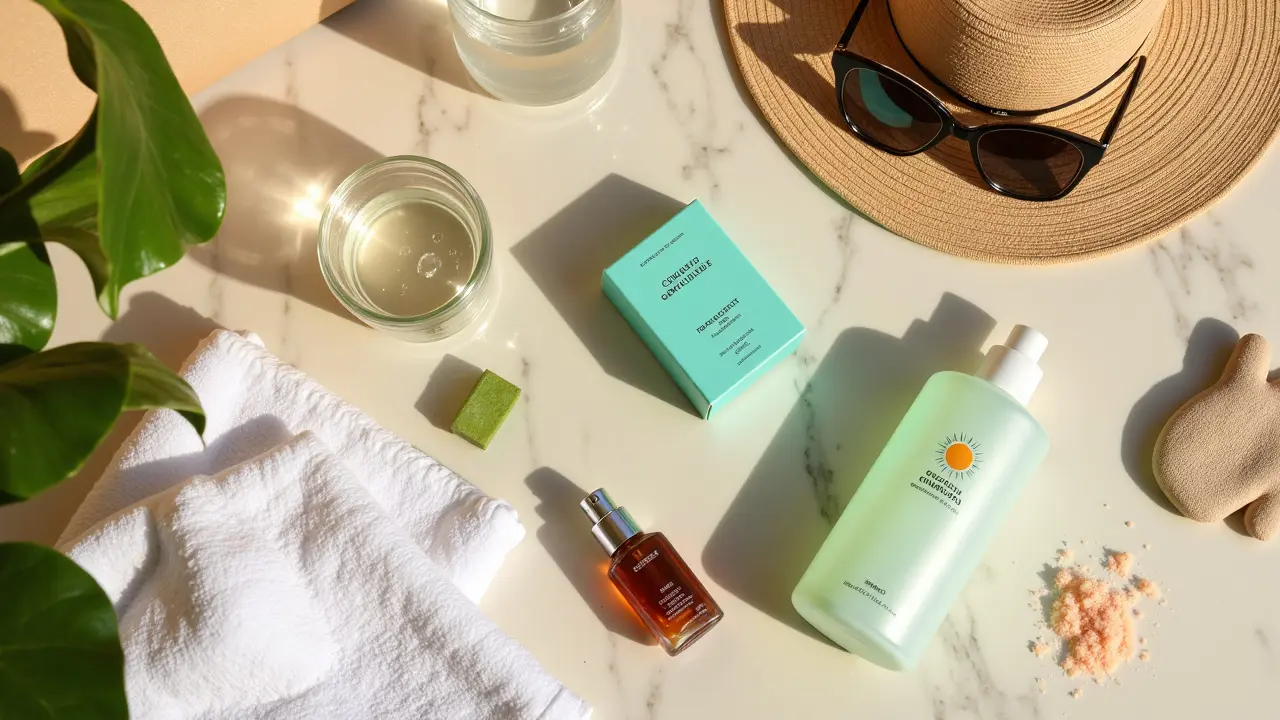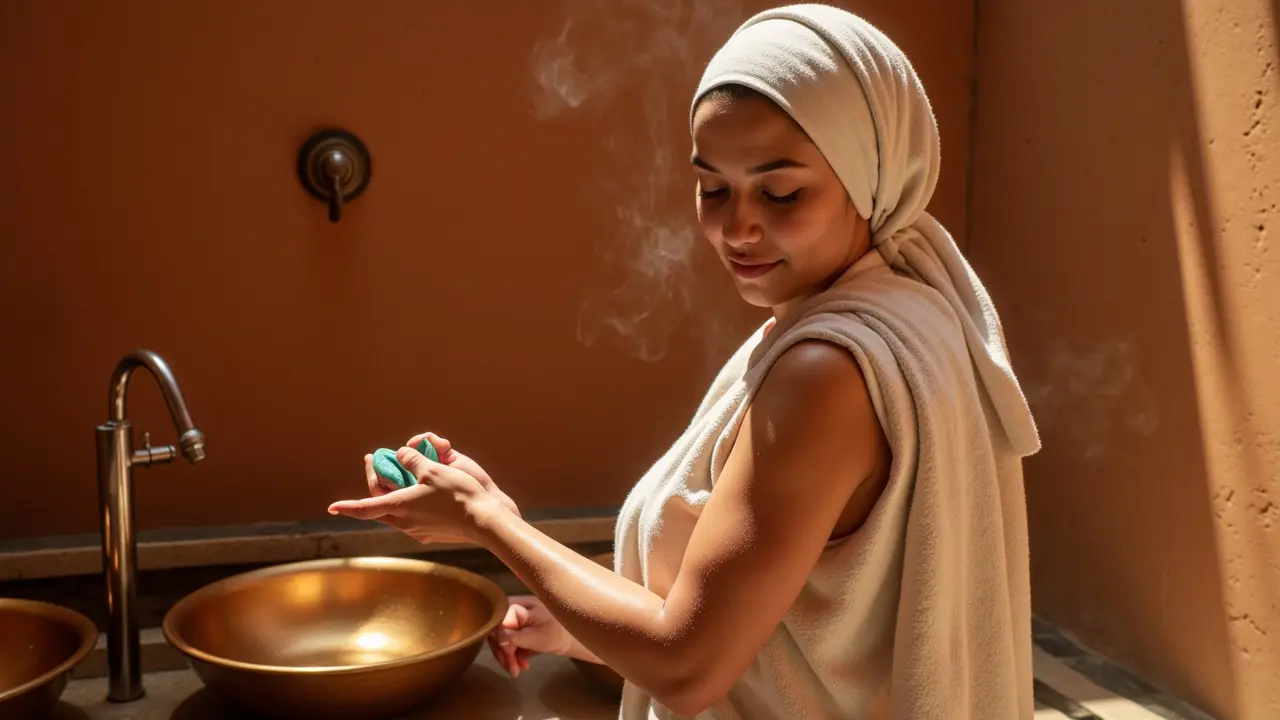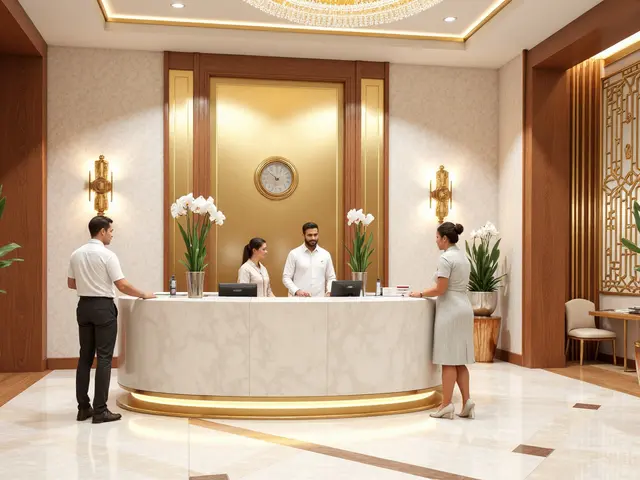You’re here for one thing: will a Moroccan bath actually remove dark spots? Short answer-no magic eraser. A proper hammam can brighten, smooth, and help lift some surface-level discoloration, but stubborn spots-sun damage, melasma, old acne marks-usually need targeted treatments. I live in Dubai, and I love a monthly hammam for that freshly-polished feel. But I don’t rely on it to fix deeper pigmentation. If you want the truth, plus what to do instead, keep reading.
Key Points & Direct Answer
Direct answer: A Moroccan bath won’t remove deep dark spots. It can fade dullness and very superficial discoloration through exfoliation, but most hyperpigmentation needs targeted ingredients (like retinoids or azelaic acid), professional peels, or lasers-always with daily SPF.
- TL;DR: Hammam = deep cleanse + exfoliation + glow. Dark spots = pigment. Exfoliation helps the surface; deeper pigment needs more.
- Works best for: dull skin, uneven texture, ingrown-prone areas, fresh surface discoloration.
- Limited for: melasma, sunspots, older acne marks, deeper dermal pigment.
- Risks if overdone: irritation and friction-triggered post-inflammatory hyperpigmentation (PIH), especially on medium to dark skin tones.
- Dubai pricing (2025): AED 150-400 in neighborhood salons; AED 450-850 in premium hotels/spas. Upgrades cost more.
What this means for you: book a hammam for glow and smoothness. Treat dark spots with smart actives and (when needed) pro treatments. Always protect the results with sunscreen.
What a Moroccan Bath Actually Is-and Where It Helps with Dark Spots
A Moroccan bath (traditional hammam) is a steam-and-scrub ritual that uses black soap (olive-based), warm steam, and a textured kessa mitt to lift dead skin. Think of it as a reset for skin that’s feeling dull, rough, or congested. In Dubai, you’ll find it in neighborhood salons, luxury spas, and hotel hammams-some classic, some modern with add-ons like mud masks or argan oil massages.
Dark spots, though, are pigment. The common types:
- Post-inflammatory hyperpigmentation (PIH): marks after acne, bites, wax burns, or ingrowns. Can be shallow or deeper.
- Sunspots (solar lentigines): from cumulative sun. Usually deeper and stubborn.
- Melasma: hormonally driven patches on face and sometimes body; easily triggered by heat and light.
Where a hammam helps: it removes the top layer of dead cells, which can make mild, fresh surface discoloration look lighter because you’re not seeing a grayish film on top of pigment. Skin immediately looks brighter and feels smoother. That “wow” glow is real, but it’s mostly texture and reflectivity, not deep pigment clearing.
Where it falls short: pigment that sits deeper in the epidermis or even dermis won’t be scrubbed away. This is why you might feel baby-smooth after your treatment yet still see the spot in the mirror. That’s normal-and it’s why dermatology guidelines differentiate between exfoliation (cosmetic) and pigment suppression (therapeutic).

Evidence, Benefits, and Limits: When a Hammam Helps vs When It Won’t
What does the science say? Dermatology guidance from the American Academy of Dermatology (AAD) and the European Academy of Dermatology and Venereology (EADV) is pretty consistent: regular exfoliation can brighten skin and improve the look of uneven tone, but established hyperpigmentation responds best to pigment-regulating ingredients (like hydroquinone, azelaic acid, retinoids, kojic acid, cysteamine) and in-office procedures (chemical peels, microdermabrasion, lasers, radiofrequency microneedling). Sunscreen is non-negotiable or pigment rebounds.
Benefits you can bank on from a Moroccan bath:
- Brightening: by shedding dull surface cells so light reflects better.
- Smoother texture: helps bumpy areas (backs of arms, thighs) look more even.
- Prevention of ingrowns: freeing trapped hairs reduces dark dots from follicle inflammation.
- Product penetration: serums and moisturizers work better on freshly exfoliated skin.
Limits to keep in mind:
- It’s not a pigment eraser: deep spots stick around until you treat the pigment-making process.
- Over-scrubbing = more spots: friction can cause PIH, especially on medium to deep skin tones (Fitzpatrick IV-VI). Go gentle.
- Melasma is heat-sensitive: hot steam and friction may trigger it. If you get melasma, keep the hammam lukewarm, brief, and skip aggressive scrubbing on face/upper chest.
What pros recommend for dark spots (face and body):
- Daily broad-spectrum SPF 50: the AAD calls sunscreen the cornerstone. Without it, any progress fades.
- Night actives, 3-5 nights/week: retinoid (tretinoin/adapalene) or azelaic acid for PIH; combine with niacinamide for barrier support.
- For body marks: add gentle body chemical exfoliants (lactic acid 5-12%, salicylic acid 2%) a few nights a week-on non-hammam days.
- Professional options: series of glycolic/lactic peels, microdermabrasion, Q-switched or picosecond lasers for sunspots, and cautious protocols for darker skin to avoid rebound PIH.
Bottom line: book a hammam for glow and texture. Layer in pigment-focused care for real spot fading. If you’re not sure what kind of spots you have, a quick dermatologist visit in Dubai can save you months of guessing.
How to Use Moroccan Bath Safely for Pigmentation: Steps, Products, and Dubai Options
Want the glow without backlash? Here’s a safe, results-first plan that plays nicely with hyperpigmentation care.
Before your session (24-48 hours):
- Pause strong actives: skip retinoids, exfoliating acids, scrubs, and waxing.
- Hydrate skin: light, fragrance-free lotion the night before helps even exfoliation.
- Test patch if sensitive: inner arm with black soap to check for stinging.
During the session:
- Ask for gentle pressure: tell your therapist you’re treating hyperpigmentation and want minimal friction.
- Keep water warm, not scalding: heat can worsen redness and melasma triggers.
- Face is optional: if you get melasma or PIH easily, avoid face scrubbing. Stick to body.
- Skip scented oils on raw skin: go for plain argan or a neutral moisturizer after.
Aftercare (the big difference-maker):
- Moisturize within 5-10 minutes: ceramide or shea butter lotion locks hydration and calms skin.
- SPF 50 every morning on exposed areas: neck, chest, arms, hands, shins. Reapply if you’re out in JBR sun.
- Restart actives smartly: 48 hours later, bring back retinoids or azelaic acid. On alternate nights, use lactic or salicylic body lotion if you’re working on body PIH.
How often? In Dubai’s climate, once every 2-4 weeks is plenty for most. More than weekly can tip you into irritation, especially if you also use acids or retinoids.
What to expect in a Dubai hammam:
- Steam room warm-up (5-15 minutes), black soap application, rinse, kessa mitt scrub, rinse again, and sometimes a clay/mud mask and oil finish.
- Session time: 45-90 minutes depending on package and add-ons.
- Privacy varies: premium spas offer private rooms; traditional spots may be communal with modesty towels.
Where to find services in Dubai:
- Neighborhood salons in Deira, Karama, and Al Barsha for budget-friendly options.
- Mid-range day spas across Jumeirah and Dubai Marina with modern rooms and optional upgrades.
- Luxury hotel spas in Downtown and Palm Jumeirah for serene, private hammams and premium products.
Pricing and booking (2025 snapshot):
- Classic Moroccan bath: AED 150-400 (salons and mid-range spas).
- Luxury hammam rituals: AED 450-850+ (hotels and resort spas, often 60-90 minutes).
- Upgrades: clay masks (AED 50-150), scalp massage (AED 80-200), body masks (AED 120-250).
Booking tips:
- Go weekday mornings to avoid crowds and get calmer steam rooms.
- Ask for “light pressure” and confirm no abrasive add-ons if treating PIH.
- If you have active eczema, open cuts, or a fresh wax/laser session, reschedule.
Pairing with pigment care at home:
- AM: vitamin C serum + niacinamide (optional) + SPF 50.
- PM (non-hammam days): retinoid 3-5 nights/week, azelaic acid or kojic acid on alternate nights.
- Body: lactic acid (5-12%) or salicylic acid (2%) lotions 2-4 nights/week on dark marks.
Derm-approved safety notes: The AAD cautions that friction and strong chemical exfoliants on the same day increase risk of irritation and PIH. Give your skin a 48-hour buffer after hammam before applying high-strength acids or retinoids.

Alternatives, Comparisons, FAQs, and Your Next Steps
Comparing your options in Dubai helps you choose the fastest, safest path for the spots you see. Use this as a quick reference:
| Treatment (Dubai) | Best For | Typical Cost (AED) | Sessions | Downtime | Spot-Fading Speed | Key Risks |
|---|---|---|---|---|---|---|
| Moroccan bath (Hammam) | Dullness, rough texture, superficial unevenness, ingrowns | 150-850 | 1 every 2-4 weeks | None to mild redness | Immediate glow; minimal change for deep spots | Over-scrub PIH, dryness if too frequent |
| Body chemical peel (AHA/BHA) | PIH on body, sunspots, rough KP patches | 350-1,200 per session | 3-6 sessions, 3-4 weeks apart | Light peeling 2-5 days | Weeks to months | PIH if too strong, sun sensitivity |
| Microdermabrasion | Surface PIH, texture, “ashiness” | 250-600 per session | 4-6 sessions | None to mild pinkness | Gradual over multiple sessions | Temporary dryness, mild irritation |
| Laser toning (Q-switched/Picosecond) | Sunspots, freckles, select PIH (expert settings) | 800-2,500 per session | 1-4 for spots; 4-8 for tone | Usually minimal; transient darkening of spots | Often faster, visible in 1-3 sessions | PIH risk on darker tones if parameters are off |
Quick decision rules:
- If your marks are new and light: try consistent SPF, actives at home, and a monthly hammam.
- If your spots are old or sun-driven: consider professional peels or targeted lasers with a reputable clinic.
- If you get PIH easily: keep friction low, choose lactic acid over harsh scrubs, and space treatments.
- If you have melasma: prioritize SPF, tinted sunscreen (iron oxides), azelaic acid, and avoid hot, aggressive hammams on the face.
FAQ-Your top questions answered:
- Will a Moroccan bath remove dark inner thighs? It may lighten the look by smoothing, but deeper thigh PIH needs SPF on the area, chafe control, and actives like azelaic or lactic acid. Consider a series of gentle body peels for faster results.
- Does it help strawberry legs? Yes for texture and ingrowns. Pair with salicylic acid body wash and a sharp razor or laser hair removal for long-term improvement.
- Is hammam safe on the face for pigmentation? If you’re prone to melasma or PIH, skip face scrubbing. Use serums instead; let the face have gentle cleansing only.
- How long until I see fading? Glow is same day. For spot fading, give actives 8-12 weeks. Pro treatments speed this up.
- Pregnant or breastfeeding? Avoid hot steam and harsh pressure; skip strong acids and retinoids. Azelaic acid is generally considered safe-double-check with your OB.
- At-home vs spa? At-home can be gentler (you control pressure), but spas deliver a more thorough exfoliation. For pigment-prone skin, gentle at-home might be safer.
- Can men do Moroccan baths for spots? Of course. Same rules: be gentle, use SPF, add actives.
Next steps and troubleshooting by scenario:
- Sensitive, reactive skin: book a shorter, lukewarm hammam; ask for minimal pressure; moisturize and use a barrier serum after; restart actives slowly.
- Body acne and dark marks: alternate salicylic acid wash (2-3x/week) with a non-comedogenic moisturizer; avoid scrubbing active breakouts; treat the acne first, then the marks.
- Deep, stubborn sunspots: consult a dermatologist for laser evaluation; keep expectations realistic and protect with SPF 50 daily, even if you mostly drive and don’t “sunbathe.”
- Melasma-prone: keep steam short and warm, not hot; skip face scrub; use tinted sunscreen daily (iron oxides help against visible light).
- Dark knees and elbows: consistent lactic acid lotion + urea cream at night works better long-term than aggressive scrubbing, which can darken these areas.
If you want the relaxation and soft-skin glow, book the hammam. If you want the spots gone, add the right pigment strategy. Ready to relax? Book your session today-and line up your SPF and night actives so the glow actually lasts.







August 26, 2025 AT 20:49
Moroccan bath gives a real surface glow but it will not erase deep dark spots or long-standing pigment.
The steam, black soap, and kessa mitt strip away dead cells and smooth texture which changes how light bounces off skin so everything looks brighter right away, that is the honest mechanism behind the instant result and not some miracle pigment removal trick.
The problem is pigment lives in melanocytes and deeper epidermal layers and a scrub cannot change the biology of melanin production, it can only remove the dull layer on top and temporarily reduce the appearance of shallow marks.
People with PIH, melasma, or sunspots need targeted actives that suppress melanin synthesis or in‑office energy devices that break pigment down, those are the places where real change happens over weeks or months and not minutes in a steam room.
There is also real risk in overdoing it; aggressive scrubbing or repeated hot steam sessions can provoke inflammation which then signals melanocytes to lay down more pigment and you end up worse off than before.
On medium to darker skin tones that feedback loop is the main reason dermatologists caution against frequent hard scrubs and unregulated abrasive treatments.
Timing is critical too, you must avoid applying strong acids or retinoids immediately after a hammam because the barrier is temporarily thinner and absorption spikes which raises irritation risk.
Smart sequencing is what saves results: gentle hammam, wait 48 hours, then reintroduce actives at conservative frequencies and keep a strict SPF routine.
In a city like Dubai, SPF is non negotiable, broad spectrum and high SPF should be used daily and liberally on any exposed skin after a hamman so the pigment does not darken again.
For body marks, consistent lactic acid or low strength AHA body lotions combined with sun protection and avoiding friction work far better than repeated scrubbing.
If you want to chase real fading, factor in clinic options like peels, microderm, or carefully selected lasers by experienced providers who understand darker phototypes.
The cost and glam of luxury hammams are great for relaxation and self care but they are not substitutes for evidence based pigment protocols.
Bottom line stay realistic use the hammam for glow and texture, not as a cure for stubborn spots, and pair it responsibly with actives and sunblock so you get benefit without creating new problems.
Do the ritual, enjoy the calm, but plan a proper pigment strategy if your marks matter to you long term.